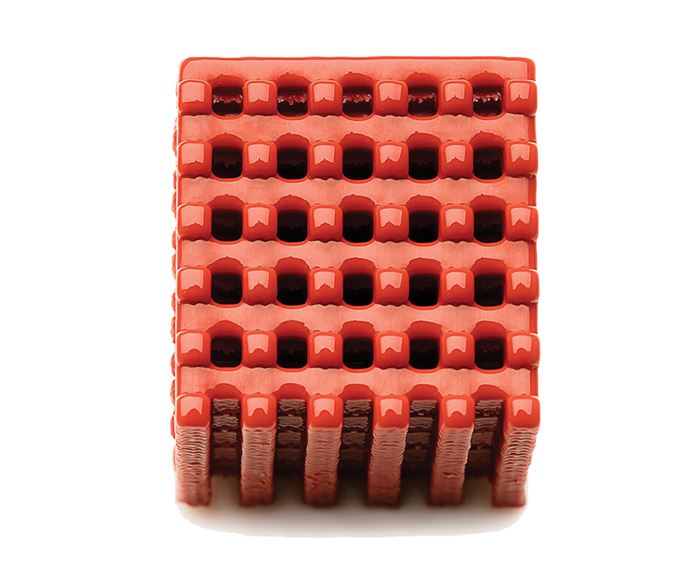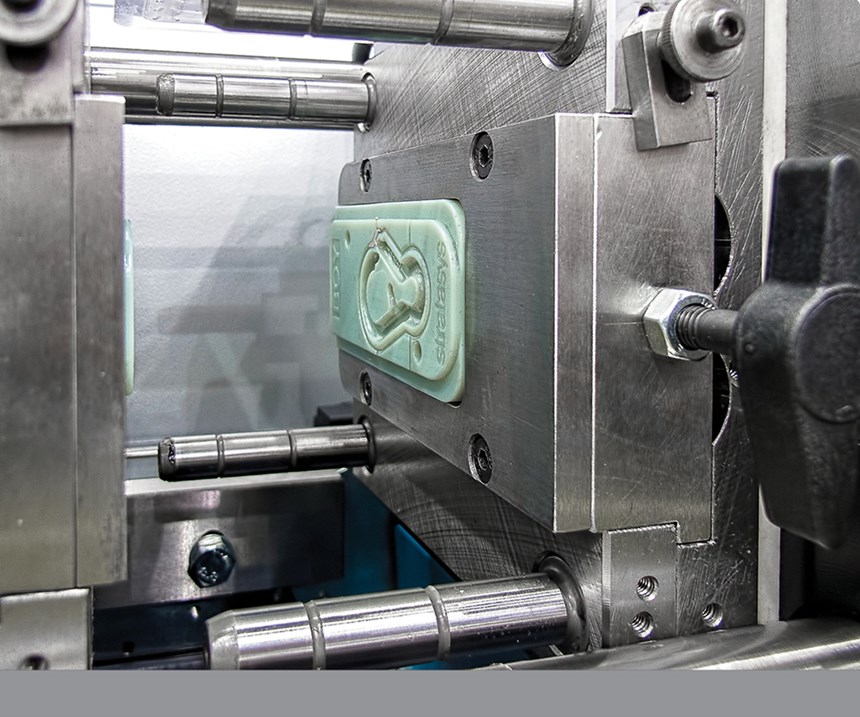K 2016 Proves Additive Manufacturing Has Staying Power
K 2016 made clear that additive manufacturing is establishing a prominent position at the triennial show among long-running mainstays like injection molding, extrusion, blowmolding and thermoforming.
Going back three years to the K 2013 show in Dusseldorf, arguably the biggest showstopper then was the world debut of the Freeformer machine for additive manufacturing from Arburg GmbH & Co KG (U.S. headquarters Rocky Hill, Conn.). Fast-forward three years to October’s K 2016 show, and the evidence is clear that this technology is not a passing fancy. This time it wasn’t just one exhibit that generated excitement around additive manufacturing (aka 3D printing), but a slew of innovations from a range of suppliers.
Here are some highlights based on reporting from Executive Editor Matt Naitove and Senior Editors Lilli Manolis Sherman and Heather Caliendo.
WORLD FIRST FOR SILICONE RUBBER
The German parent of Wacker Chemical Corp. Adrian, Mich., presented what it called the “first industrial 3D printer for silicones,” the ACEO Imagine Series K, which was operating at its booth throughout the show. The company says that silicone experts developed a unique system solution—consisting of material, software, and hardware—to open up new opportunities for industries such as healthcare, automotive, and electronics. ACEO technology uses a drop-on-demand method. The printer head deposits tiny silicone droplets on a substrate. In this way, the workpiece is built up layer by layer. The silicone is formulated so that the droplets flow together before the curing process begins, which is activated by UV light. The droplets and layers produce a homogeneous workpiece, which the com- pany claims “does not differ much from injection molded parts.” With the aid of water-soluble support materials, it is also possible to create overhang materials and internal lattices.
“ACEO technology can be used to make parts and assemblies with complex geometries, as well as ‘impossible products’ that could not previously be produced,” explains Bernd Pachaly, head of Wacker’s silicones research and responsible for the ACEO team.
Wacker is currently building its own technology center—the “ACEO campus”—near its main site in Burghausen, Germany. In the future, customers will be able to test their own product ideas in an Open Print Lab.
3D-PRINTED PLASTIC MOLDS
Stratasys, Inc., Eden Prairie, Minn., a leading supplier of 3D-printing equipment and materials, devoted its exhibit almost entirely to displays of plastic tooling and parts made from it. The exhibit also featured Stratasys’ new Polyjet J750 printer, which can print up to six different colors or materials at the same time. It does that by dispensing droplets of different colors or materials on top of each other, inkjet style, so they mix before being hardened (crosslinked) by UV light.
The capabilities of 3D-printed plastic tooling are best illustrated by what molders are doing with it. According to Gil Robinson, Stratasys sr. application engineer, they are running nylon, polycarbonate, acetal, PPE alloys, and PPS—even some glass-filled grades—as long as injection temperatures remain below 300 C (572 F). The number of shots that can be achieved depends on the material and the part. Robinson said the printed tooling inserts can last for five to 20 parts in nylon or PC, 50 to 100 parts in polyolefins, and up to 700 to 800 shots in acetal. The more complex the geometry, and the thinner the walls, the shorter the tool life.
Stratasys showed at K that printed plastic molds can also be used to prototype blow molded bottles and thermoformed shapes. In the case of thermoforming, a different type of Stratasys printer, using the FDM process of extruding and fusing thin plastic filaments, produces a porous mold that needs no drilling of vacuum holes. Other exhibits displayed printed plastic layup tools for vacuum bagging continuous-glass composites. In one case, soluble material was used to print a core for laying up a composite tube with curves and bends. The printed core could be washed out after curing the carbon-fiber/epoxy part. (See also this month’s report on hot runners and tooling news at K.)
ADVANCES IN 3D PRINTING MATERIALS
ABS specialty compounder Elix Polymers, Tarragona, Spain (Elix Polymers Americas LLC) made its debut at the K. The company is developing advanced versions of ABS specifically for 3D printing using Fused Filament Fabrication (FFF). Elix is seeking materials that will produce parts with better mechanical properties, including good impact resistance, low warpage, strong dimensional stability, and high resolution. Solvay, Alpharetta, Ga., showcased a 3D-printed functional air-intake manifold designed for the Polimotor 2 racing-car project. It is produced with the company’s Sinterline Technyl nylon 6 powder on an SLS (selective laser sintering) machine. The company printed the part with a 30% weight reduction by applying Solvay’s predictive simulation package, MMI Technyl Design, for the first time. That lightweighting contributed to the goal of designing this engine to weigh 138-148 lb, 90 lb less than a standard production engine today.
Covestro LLC, Pittsburgh, also touched on interesting 3D-printing technology applicable to several industries. Within athletics, the company discussed opportunities in footwear, with Covestro officials seeing that market as the most rapidly developing in terms of commercial additive manufacturing. At this time, Fused Filament Fabrication (FFD) is being applied with TPU and PC filaments. TOPAS Advanced Polymers, Inc., Florence, Ky., discussed commercial strides in 3D printing with its Topas cyclic olefin copolymer (COC). Dolomite Microfluidics, also of Florence, Ky., developed a new 3D printer, the Fluidic Factory, for making prototypes of fluidically sealed devices such as chips, sensor cartridges, fluid manifolds, valves, and connectors. The company opted to use a filament of Topas COC, a polymer frequently requested by biologists and which has great acceptance in the microfluidic industry.
A. Schulman, Inc., Fairlawn, Ohio, also discussed its progress toward commercialization of its Shulasint nylon 12 powders for SLS additive manufacturing, with samples exhibited at the show. Polyscope (U.S. office in Novi, Mich.), is developing filaments for FDM 3D-printing technology. To be launched in the first half of 2017, the initial offerings will include ABS, which the company says surpasses existing ABS filaments in terms of dimensional stability and interlayer adhesion. Filaments for use with SLS technology are also being explored. In collaboration with AIMPLAS Plastics Technology Centre in Valencia, Spain, early functional parts target healthcare, appliances, automotive, and electronics industries.
NEW 3D-PRINTING PROCESS FOR AIRCRAFT
A new collaborative development among Airbus Group Innovations (Suresnes, France), LSS Laser Sinter Service (Holzwickede, Germany) and Lehmann & Voss & Co. (Hamburg, Germany) was announced at K 2016 for the new ThermoMELT 3D printing process to be commercialized by Airbus. This technology is said to reduce the cost of production with high-performance polymers—and to allow new high-performance polymers to be used—by lowering sintering temperatures. German service bureau Rauch CNC will also join this collaboration as a partner for testing ThermoMELT to ensure it fulfills market requirements.
ThermoMELT allows the production of parts using high- performance materials in slightly modified commercial SLS machines. These modifications will provide better thermal and laser control to the system. ThermoMELT is said to significantly reduce thermal aging effects during the manufacturing process, increasing recyclability and reducing costs compared with standard additive-manufacturing techniques.
Related Content
Prices for All Volume Resins Head Down at End of 2023
Flat-to-downward trajectory for at least this month.
Read MoreUnderstanding the ‘Science’ of Color
And as with all sciences, there are fundamentals that must be considered to do color right. Here’s a helpful start.
Read MoreThe Effects of Temperature
The polymers we work with follow the same principles as the body: the hotter the environment becomes, the less performance we can expect.
Read MoreResin Prices Still Dropping
This downward trajectory is expected to continue, primarily due to slowed demand, lower feedstock costs and adequate-to-ample supplies.
Read MoreRead Next
Why (and What) You Need to Dry
Other than polyolefins, almost every other polymer exhibits some level of polarity and therefore can absorb a certain amount of moisture from the atmosphere. Here’s a look at some of these materials, and what needs to be done to dry them.
Read MoreTroubleshooting Screw and Barrel Wear in Extrusion
Extruder screws and barrels will wear over time. If you are seeing a reduction in specific rate and higher discharge temperatures, wear is the likely culprit.
Read More



























